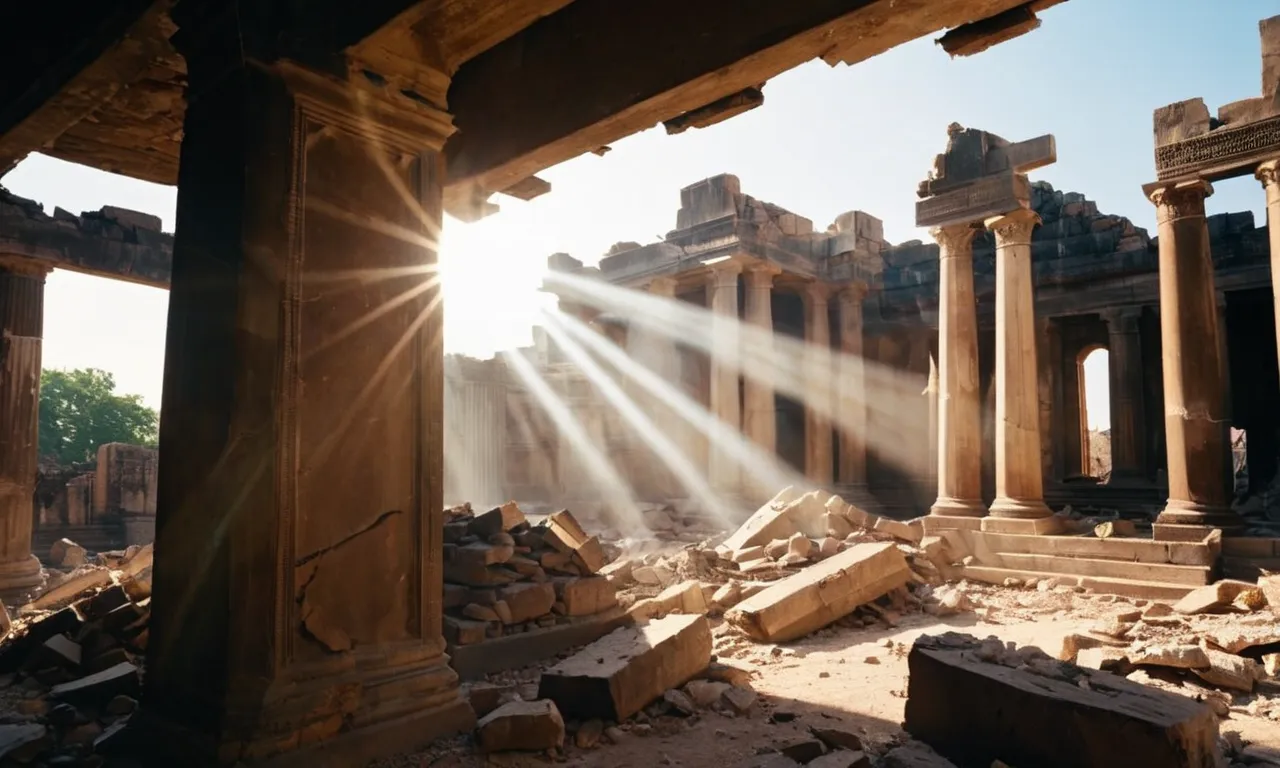Why Did Jesus Destroy The Temple?
The cleansing of the temple is one of the most dramatic episodes in the life of Jesus. Sending money changers and merchants fleeing, Jesus overturned tables and condemned the temple authorities for turning God’s house into “a den of robbers.”
If you’re short on time, here is a quick answer: Jesus destroyed the temple because he was angry that a house of prayer and worship had become corrupted by commerce and greed.
In this comprehensive article, we will examine the temple cleansing in detail – what exactly happened, the Old Testament background, the symbolic meaning, and why Jesus took such shocking and provocative action against the temple establishment of his day.
The Temple Cleansing Event
The Money Changers in the Temple Courts
During the time of Jesus, the temple in Jerusalem was an important place of worship for the Jewish people. People would come from all over to offer sacrifices and worship God. However, the temple courts had become filled with money changers and merchants selling animals for sacrifice.
According to the Gospel accounts, these merchants were cheating people by overcharging for animals and exchanging foreign currency at unfair rates (Matthew 21:12–13, Mark 11:15–17, John 2:13–16). This rotten business angered Jesus because it took advantage of poor pilgrims coming to worship.
The money changers and merchants had turned God’s house into a marketplace!
Jesus Drives Out the Merchants and Money Changers
Jesus responded by driving out the merchants and money changers in a dramatic scene. He overturned their tables and cleared the temple courts, declaring “It is written, ‘My house will be called a house of prayer,’ but you are making it ‘a den of robbers'” (Matthew 21:13).
This cleansing of the temple signified God’s judgment on the corruption and greed that had infected worship. Jesus wanted true worship, not profiteering. His actions also fulfilled Old Testament prophecy about the Messiah coming to purify the temple (Malachi 3:1–3).
The excited crowds welcomed Jesus’ cleansing of the temple, but it infuriated the chief priests and teachers of the law who rebuked Jesus (Luke 19:47–48).
Reactions from the Temple Authorities
The temple cleansing threatened the power of the temple authorities who profited from the business dealings. They immediately began looking for ways to destroy Jesus (Mark 11:18). This event was a major escalation in the conflict between Jesus and the religious establishment.
According to theologian Dane Ortlund, “By revealing the temple’s need for cleansing Jesus was making an implicit statement about the temple itself. It needed not merely to be cleansed but to be replaced.”
This foreshadowed Jesus’ prediction that the temple would be destroyed and his claims to be the fulfillment of true worship (John 2:19-22). The temple authorities failed to understand that God desired sincerity of heart, not outward ritual.
Their reaction against Jesus further aligned them against God’s purposes.
Old Testament Background
Prophecies of a Desecrated Temple
The Old Testament contains several prophecies about the temple in Jerusalem being desecrated or destroyed as punishment for the people’s unfaithfulness to God. For example, the prophet Jeremiah warned that God would make the temple like Shiloh if the people did not repent (Jeremiah 7:12-14).
Shiloh was the site of the tabernacle in early Israelite history before the construction of the temple, but it was destroyed by the Philistines. This imagery of a destroyed holy site symbolized God’s judgment on the people’s sin.
The prophet Ezekiel had visions of God’s presence leaving the temple because of the people’s idolatry and violence (Ezekiel 8-11). Ezekiel sees detestable images provoking God to anger in the temple courts.
This vision is a symbolic condemnation of Judah’s sin and a prediction that the temple would be destroyed along with Jerusalem itself soon afterwards in 587 BC by the Babylonians.
So the idea of a desecrated or destroyed temple was an established prophetic warning in Israel’s history that unfaithfulness to God would result in his judgment. The people regarded the temple as indestructible with an unwarranted confidence because of God’s presence there, but the prophets declared that apostasy could cause even this sacred site to be abandoned and demolished by God’s permission.
Symbolic Significance of the Temple
The Jerusalem temple was centrally important in Israel’s covenant relationship with God. It was seen as the intersection between God’s heavenly dwelling and the earthly realm. The innermost sanctuary housed the very presence of God in the ark of the covenant.
So the integrity and holiness of the temple represented the state of Israel’s covenant fidelity to God. A desecrated temple pictured a polluted covenant relationship. Ezekiel stresses this symbolism in his temple visions where God’s presence retracts step by step from the temple due to the people’s increasing idolatry and injustice.
By the time of Christ, the emphasis on ritual purity in the temple by groups like the Pharisees was likely compensation for the lack of true fidelity to God in many people’s hearts.
The hope of the prophets was that God would one day renew the people’s hearts by his Spirit so that their lives rather than just the buildings of stone would become the true dwelling place of God (Ezekiel 36:24-28). But the temple remained central to the Jewish hope of restoration.
Jesus Fulfilling Malachi’s Prophecy
When Jesus drove out the money changers and merchants from the Jerusalem temple courts (Matthew 21:12-17; Mark 11:15-19; Luke 19:45-48), he was enacting a prophetic sign of coming judgment on apostate Israel.
Jesus quotes Isaiah 56:7 and Jeremiah 7:11, evoking these prophecies of temple destruction as punishment for corruption. Though his actions provoked temple authorities, many common people welcomed Jesus’ confrontation of temple greed and corruption.
This symbolic demonstration aimed to expose the idolatry of economic exploitation that had infected worship practices. Though supposedly functioning as a “house of prayer for all nations”, the temple site had become a religious market catering to the wealthy.
The money changers and sellers got rich from temple taxes and animal sales while average people were exploited. Jesus condemned this unjust hierarchy and “den of robbers” that barred genuine access to God.
So in driving out merchants from the temple, Jesus set himself in the line of Israel’s prophets. Indeed, he quite directly enacts the prophecy of Malachi 3:1, “the Lord whom you seek will suddenly come to his temple.”
Jesus fulfills this expectant waiting for God’s coming to purify the temple and the priests serving there. Jesus presents himself as this prophetic messenger destined to refine and restore righteous worship.
So his shocking temple demonstration enacted his mission to cleanse and reshape corrupt worship practices in preparation for God’s immanent kingdom. Jesus shows the temple to be “desecrated” in God’s eyes by economic injustice.
His attack on temple commerce displays his authority to critique existing structures in light of God’s ideals. He seeks to transform attitudes not just regulate activities. In this prophetic sign act, Jesus reveals his radical vision to renew authentic worship and faithfulness to God.
The Zeal and Righteous Anger of Jesus
Indignation at Exploitation of Worshipers
Jesus displayed passionate zeal and righteous anger when he saw the temple courts being used for commerce and profit. As worshipers came to offer sacrifices, they were being exploited by those selling animals and exchanging money at excessive rates (Matthew 21:12-13).
Jesus was indignant that a place set apart for prayer and sacrifice had become distorted into a marketplace.
In a startling act, Jesus drove out all who were buying and selling, overturning the tables of the money changers and seats of those selling doves (Mark 11:15-17). This cleansing of the temple demonstrated Jesus’ zeal for pure worship, unhindered by greed or corruption.
Confronting Greed and Corruption
The merchants and money changers in the temple courts were likely charging exorbitant fees and high exchange rates to pilgrims coming for Passover (John 2:13-16). What should have been a holy act of sacrifice was being exploited for profit.
Jesus was furious at this fleecing of average people seeking to be obedient in worship.
In a prophetic act, Jesus condemned the temple leadership for turning God’s house into a “den of robbers” (Matthew 21:13). He accused them of disregarding the covenant with God and failing to lead the people justly before Him.
Rather than greed and gain, the temple was meant to exhibit truth, prayer and inclusiveness of all people under God.
Jesus’ anger came from a pure motive – defending those who couldn’t stand up to an unjust system and calling religious leaders back to faithfulness. His righteous indignation against piety for profit continues to convict exploitation done in the name of religion today.
A Prophetic Act Foreshadowing Destruction
Judgment on Temple Authorities
When Jesus drove out the money changers and merchants from the temple courts, He was passing judgment on the corruption and greed of the temple authorities. The temple was meant to be a house of prayer for all nations, but they had turned it into a den of thieves through their shady business practices and exploitation of worshippers.
Jesus was furious at how they had desecrated God’s house for their own gain. His actions foreshadowed how the temple would soon be destroyed as part of God’s judgment on Jerusalem.
Jesus was effectively condemning the corrupt religious leaders who cared more about making money than true worship. He accused them of neglecting justice, mercy and faithfulness in favor of enriching themselves at the expense of ordinary people trying to connect with God (Matthew 23:23). His attack on temple commerce was a prophetic sign that their self-serving religious system would not stand.
Sign That Temple Would Be Destroyed
Christ’s dramatic cleansing of the temple also foreshadowed its eventual destruction by the Romans in 70 AD due to the rebellion of the Jews. Jesus predicted this would happen within a generation because the people had rejected Him as Messiah (Matthew 24:1-2). His assault on temple activities was an enacted parable that its days were numbered.
When confronted by the Jewish leaders about His actions, Jesus replied, “Destroy this temple, and I will raise it again in three days” (John 2:19). This indicated the temple’s destruction, and His body representing a new spiritual temple that would rise again in His resurrection.
Jesus’ prophecy was fulfilled when the Romans sacked Jerusalem and burned the temple only a few decades later.
So Christ’s zeal for God’s house was ultimately a dramatic demonstration that the temple’s purpose had become obsolete. His sacrifice on the cross accomplished atonement for sin once and for all. The corrupted religious system centered on temple worship was being replaced by Christ Himself as the new, true temple and only mediator between God and humanity (1 Timothy 2:5).
Conclusion
In this comprehensive examination of Jesus’ shocking actions in the temple, we have seen that he was moved to righteous anger because the house of God had become corrupted. The merchants and money changers were fleecing pilgrims and exploiting people’s desire for worship.
Jesus condemned the greedy temple authorities who allowed this, prophesying that their self-serving religious system would soon be destroyed.
The cleansing of the temple highlights Jesus’ determination to stand up against injustice done in the name of religion. He is a reformer concerned with defending and restoring true worship – a theme which will culminate in his own sacrificial death on the cross.








